Cantonese shumai are fresh, juicy pork and shrimp filled dumplings with thin, bright yellow wrappers. Learn how to make shumai like the ones at a dim sum shop.
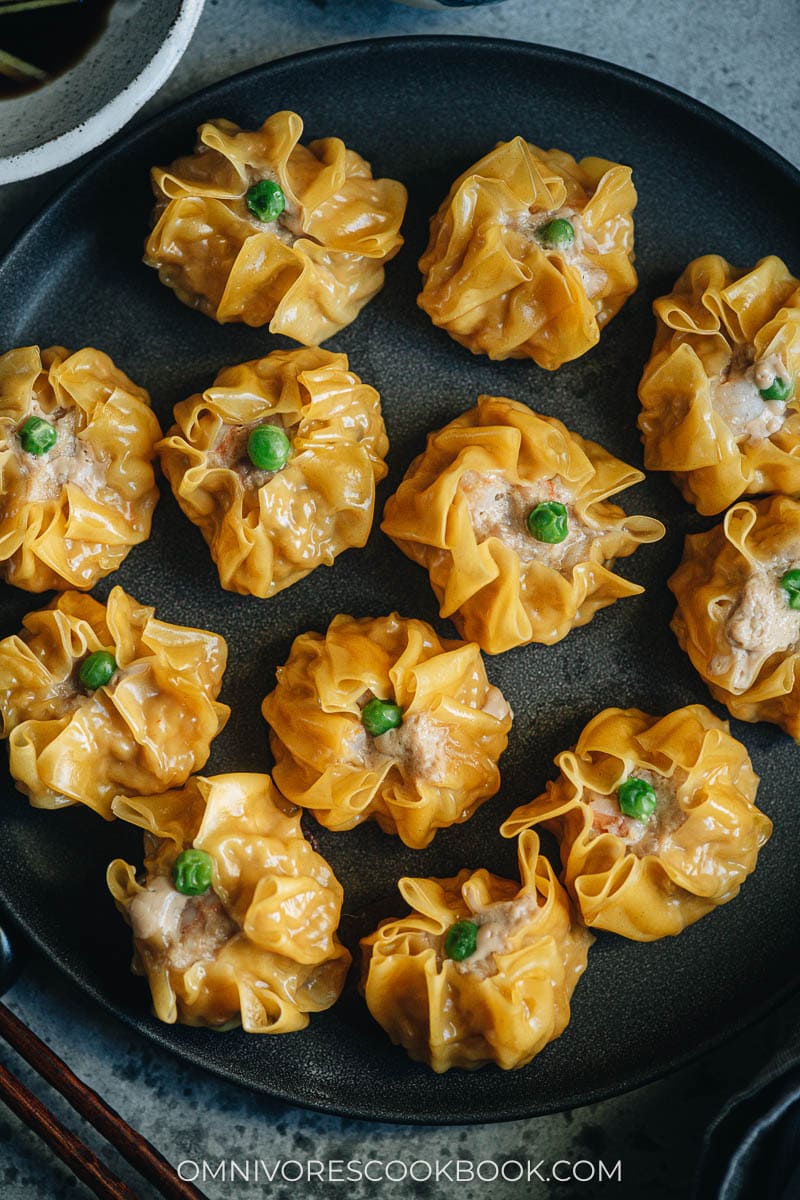
Cantonese shumai (烧卖, Shao Mai) are one of the most popular dim sum dishes. They are steamed open-face stemmed dumplings filled with pork and shrimp. Back in China, whenever we’d have Cantonese dim sum, the pork and shrimp shumai and crystal shrimp dumplings (har gow) were our must-order dishes.
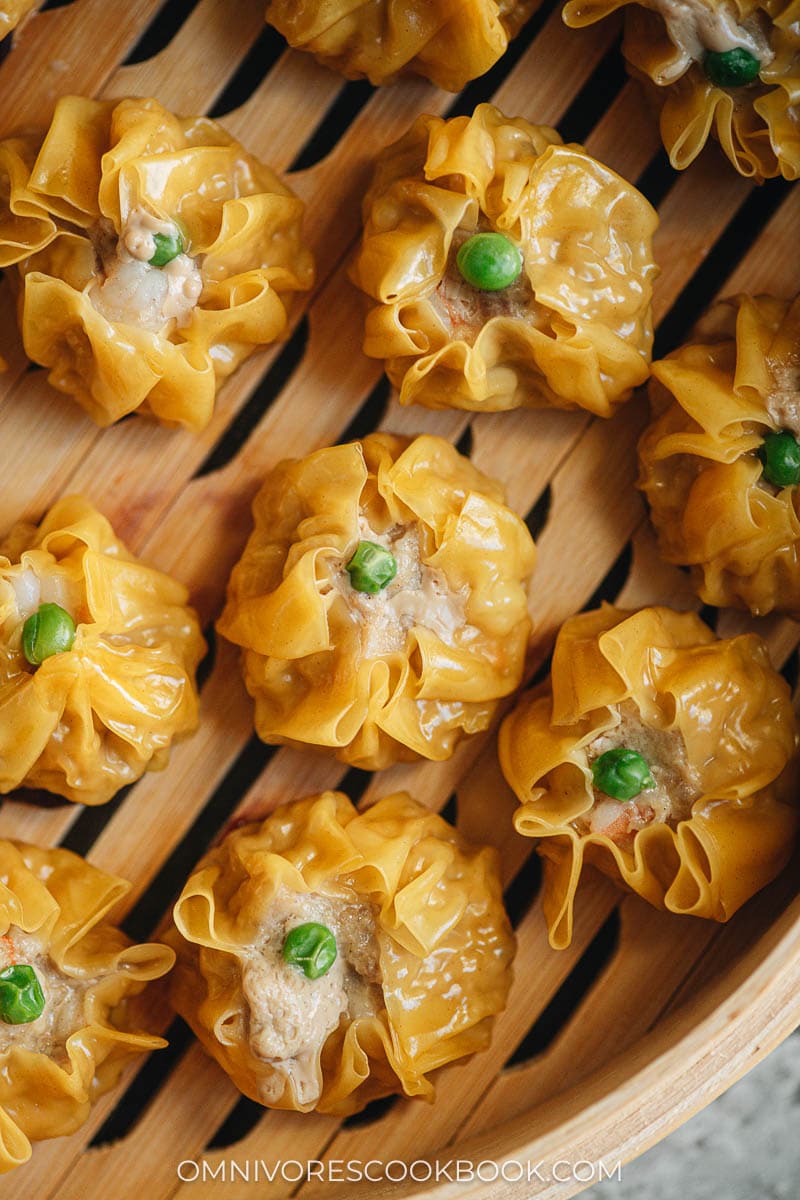
Shumai ingredients
What type of wrapper to use
To make the most authentic tasting Cantonese shumai, you should use Hong Kong Style Dumpling Wrappers. They are thin round wrappers that have a yellow color. You can find this type of wrapper at Chinese markets and some Asian markets (such as H Mart). They are usually located in the refrigerated or freezer section. If you cannot find this type of wrapper, it’s OK to use a regular dumpling or gyoza wrapper with a white color.
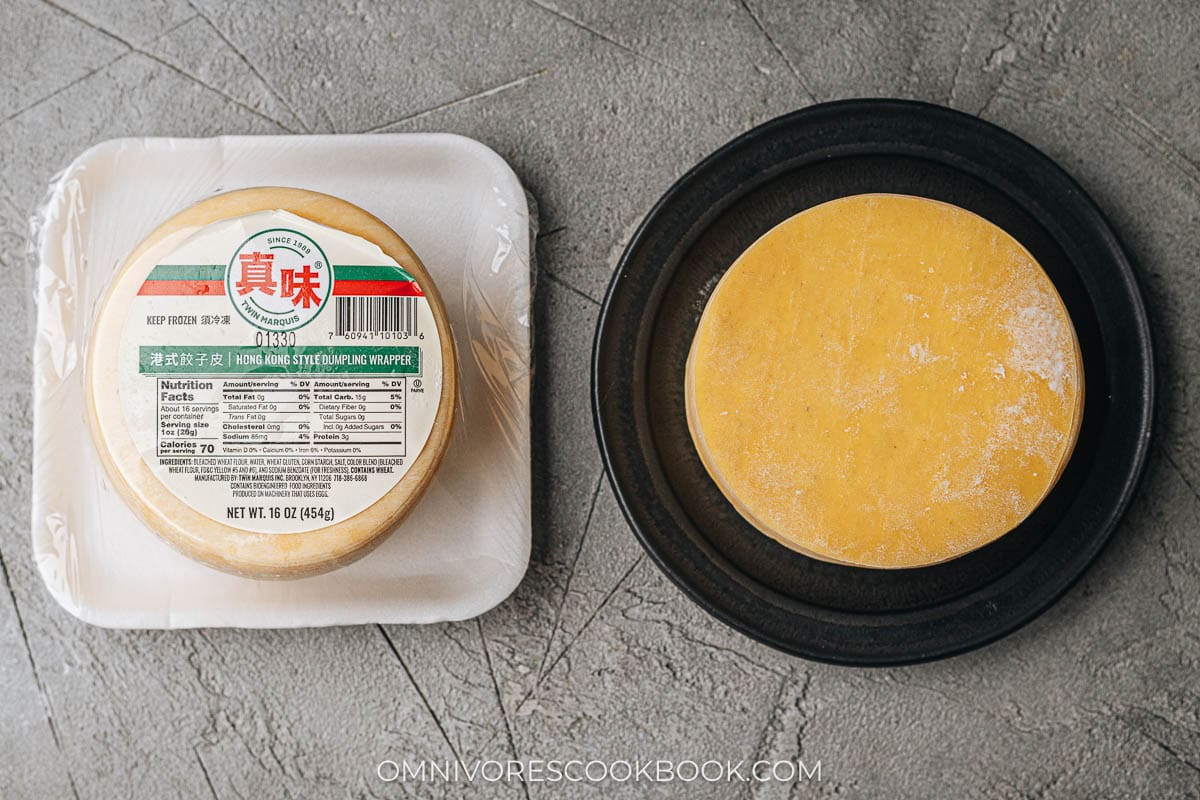
The filling
The classic Cantonese shumai always use a pork and shrimp combo filling for the best mouthfeel and taste. If possible, pick a fattier mix of ground pork so the filling is juicier. For the shrimp, you will mince most of them and mix it into the pork. A small portion of shrimp will be chopped into small pieces for a distinctive texture.
This recipe uses a traditional approach – hand chopping all the ingredients for the filling. Alternatively, you can also use a food processor to make the filling. I have included both methods in the recipe below.
Seasonings
Cantonese shumai seasoning is quite different from the one used for northern style steamed dumplings. Shumai emphasizes a clean taste that brings out the freshness of the ingredients. Also all the ingredients should be well blended together to form a chewy texture, without any large bits of aromatics. After many experiments, I found a perfect combination and quantity for the ingredients below:
- Shaoxing wine
- Oyster sauce
- Light soy sauce
- Grated ginger
- Toasted sesame oil
- Sugar
- Salt
- White pepper powder
Some common dumpling ingredients such as shiitake mushrooms and green onions are eliminated, to create a taste that is just like they have at dim sum restaurants.
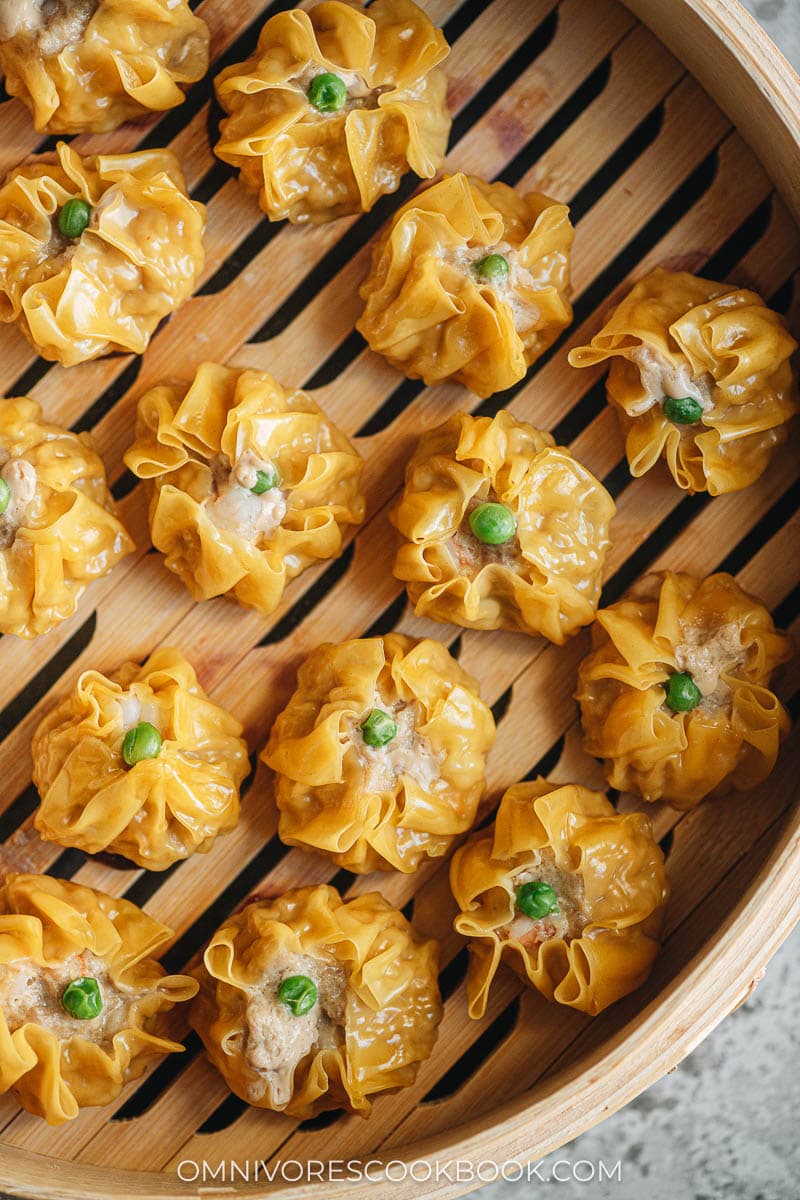
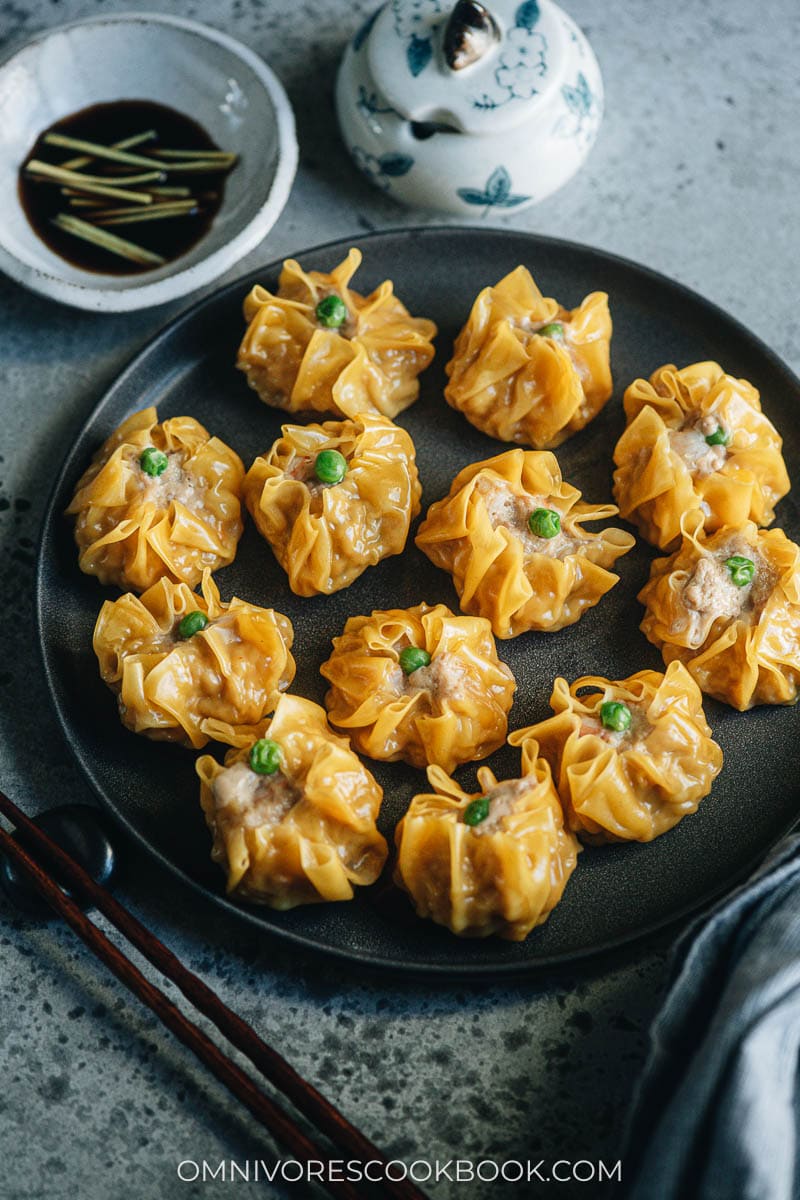
How to make Shumai
Make the shumai filling
The most important part of making shumai filling is to beat the pork and shrimp mixture with cornstarch and eggs to form a sticky paste (上劲, Shang Jin). By doing this step, the meat will absorb the liquid and become juicy, without turning soggy. The meat will become quite sticky, which makes the wrapping easier, and it yields a chewy texture once cooked.
Once the meat and shrimp are properly beaten, you can then add the rest of the seasonings.
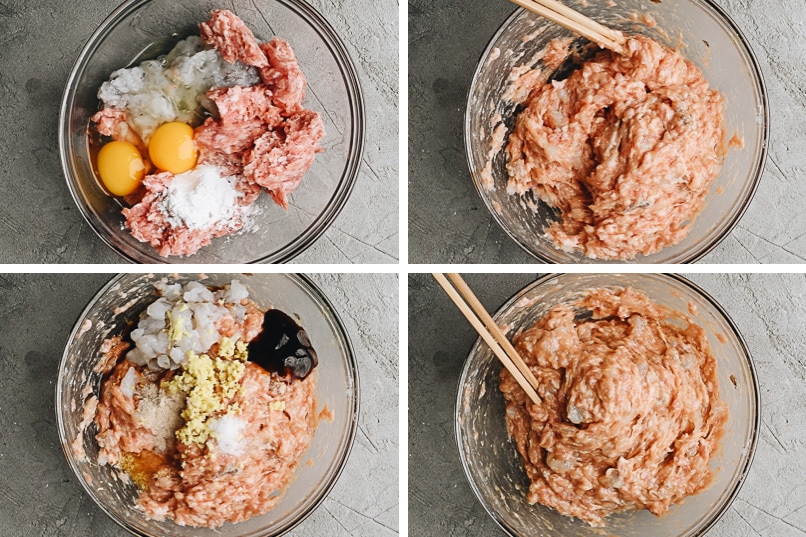
Assemble shumai
Assembling Shumai is very easy and forgiving, and it is much easier than making potstickers.
- Lightly wet the edge of the wrapper
- Place about 1 tablespoon of filling in the center
- Gather the wrapper and make pleats if you like. If you do not want to fold the pleats, you can simply press the wrapper with the filling so it forms a short cylinder. Then use your thumb and index finger to lightly press the top without closing it, while using the other hand to hold the bottom to pack the filling in. (see my video below for the process)
- Garnish each shumai with a green pea
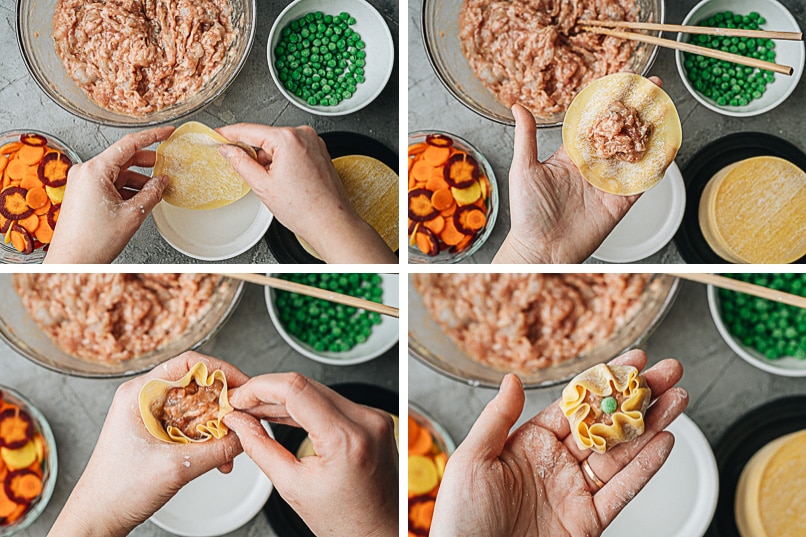
P.S. Making shumai usually does not require wetting the wrapper, because you don’t need to seal up the opening. However, I found this step to be helpful when the wrappers have gotten a bit dry, and it makes the wrapping easier.
How to cook shumai
You will need a steamer to steam the shumai. You can either use a stainless steel steamer or a bamboo steamer. If you use a bamboo steamer, you will need a big pot such as a wok to hold the steamer.
For either steamer, you usually need to use a parchment paper liner or cheesecloth to line the basket so the shumai won’t stick. In this recipe, I used sliced carrots under each shumai, to prevent it from sticking. I learned this trick from my favorite dim sum restaurant back in China. If you do not want to use the carrot method, make sure to line your steamer before cooking.
Once you set up the steamer, it only takes a few minutes to cook the shumai.
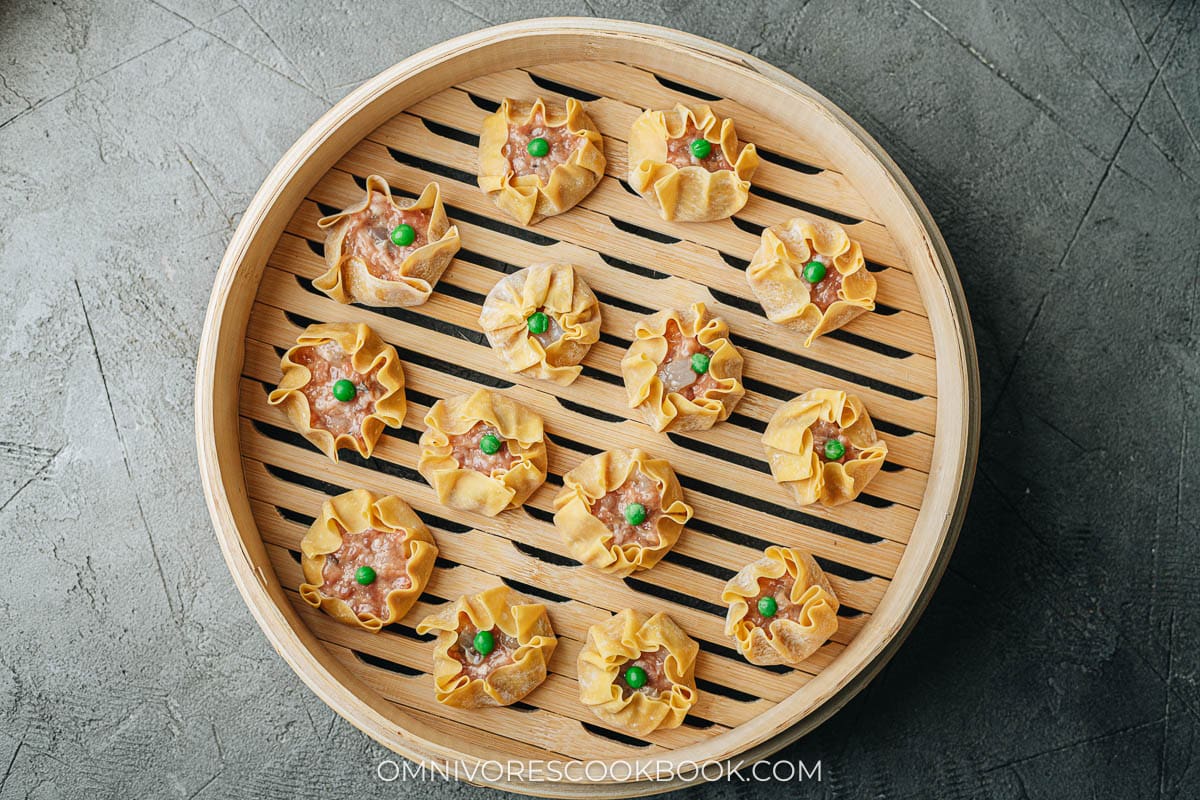
How to serve shumai
Shumai are usually served hot in small quantities as an appetizer, or as one dish of a multi-course meal. Since Cantonese dim sum is all about freshness, you should always cook the shumai right before serving, and only cook the portion you plan to eat.
Most Cantonese restaurants serve the shumai as they are, without any dipping sauce. If you want to use a dipping sauce, I found that Chinkiang vinegar with a few slivers of ginger works extremely well. When you dip the shumai into the vinegar, it somehow tastes a little like crab. If you think these shumai are not salty enough, you can also add a few drops of soy sauce into your dipping sauce.
How to store and reheat shumai
Shumai store very well in the freezer, so they make a perfect dinner party dish. You can wrap the shumai and store them uncooked. Right before serving, simply steam the frozen shumai without thawing. They taste just as great as fresh ones.
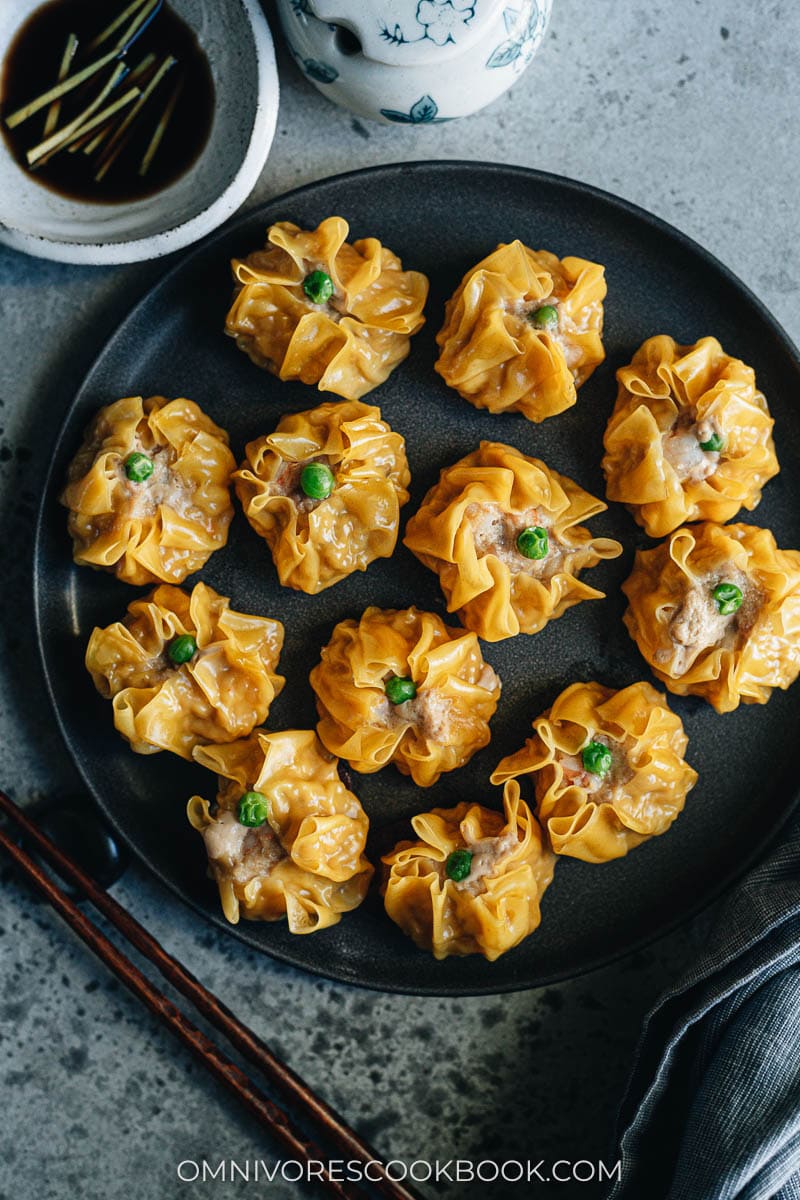
Afterthoughts
Shumai is one of my favorite dim sum goodies to make at home, because they are very easy to wrap and they store very well. They look very pretty and impressive, too – a perfect appetizer to serve at any dinner party. I hope you enjoy this one and happy cooking!
More dim sum recipes
- Cantonese Wonton Noodle Soup
- Pineapple Buns (Bolo Bao)
- Steamed Ribs in Black Bean Sauce (豉汁蒸排骨)
- Chinese Turnip Cake (Lo Bak Go, 萝卜糕)
- Air Fryer Char Siu Pork (空气炸锅叉烧肉)

Cantonese Shumai with Pork and Shrimp (烧麦, Shao Mai)
Ingredients
Pork and Shrimp Shumai
- 30 Hong Kong Style dumpling wrappers , thawed if using frozen wrappers
- Frozen peas for garnish (Optional)
- 1 large carrot , sliced thinly into rounds (Optional)
Filling
- 1/2 lb (250 g) shelled and deveined raw shrimp
- 10 oz (330 g) ground pork (20% fat)
- 2 eggs
- 2 teaspoons cornstarch
- 2 teaspoons Shaoxing wine (or dry sherry)
- 1 tablespoon oyster sauce
- 1 teaspoon light soy sauce (or regular soy sauce)
- 1 teaspoon grated ginger
- 1/2 teaspoon sugar
- 1/4 teaspoon salt
- 1/4 teaspoon white pepper powder
- 1 tablespoon toasted sesame oil
Dipping sauce
- 3 tablespoons Chinkiang vinegar
- 1/2 thumb ginger , thinly sliced
Instructions
Prepare the filling without a food processor
- Reserve 3 to 4 shrimp, and chop them into small pieces. Mince the rest of the shrimp as finely as possible.
- Combine the shrimp, pork, egg and cornstarch. Beat the mixture with a pair of chopsticks or a wooden spatula until the mixture is very sticky.
- Add the rest of the filling ingredients and the reserved shrimp pieces. Mix very well, until smooth and sticky.
Prepare the filling with a food processor
- Reserve 3 to 4 shrimp, and chop them into small pieces. Add the rest of the shrimp into the food processor. Pulse the food processor until the shrimp are coarsely chopped.
- Add the rest of the filling ingredients. Mix until everything is evenly chopped into a fine paste and becomes very sticky.
- Transfer the paste into a big bowl and add the reserved shrimp pieces. Stir to mix well.
Assemble the shumai
- Work on the shumai one by one. Place a dumpling wrapper on a clean work surface. Wet the edge lightly with water. Place 1 tablespoon of filling in the center of the wrapper. Bring the edges up around the filling, pinching and pleating, leaving the top open. Then use your thumb and index finger to lightly press the top without closing it, while using the other hand to hold the bottom to pack the filling in. Garnish with a green pea. Place a slice of carrot on the bottom, if using. Repeat with the remaining wrappers.
- Line your steamer with a clean, wet cheesecloth or steaming parchment (you can skip this if using the carrot liner). Transfer the shumai into the steamer basket, one finger’s width apart.
- Heat a large pot of water over medium-high heat until boiling. Cover the steamer basket and place it over the pot. Steam over boiling water for 7 to 8 minutes, until cooked through.
- Serve by itself or with a Chinkiang vinegar and ginger dipping sauce.
Store and cook frozen
- Place the uncooked shumai on a lightly greased baking sheet, one finger’s width apart. Cover the sheet with plastic wrap. Freeze the shumai until completely frozen. Then you can transfer them to bags or containers to save freezer space.
- Steam the frozen shumai without defrosting or thawing. After bringing the water to a boil, steam until completely cooked through, 15 minutes or so.













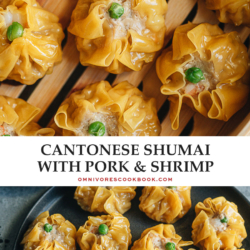
I got this great new bamboo steamer for christmas and haven’t had the chance to use it yet. And I love shumai, so perhaps this should be my first recipe! I’ve never made shumai before, so I can see this being a learning experience, but am determined to start making my own dim sum. Plus I love that you can make these ahead of time and freeze them. It’s perfect!
These are a classic! such a great tutorial on making these beauties! thank you for the great recipe and post 🙂
Oh, these are some beautiful photos and I think these dumplings look spectacular.
I would love to see a video on wrapping Shumai. That would really be helpful for the totally inexperienced. Thanking you in advance.
This is a fantastic recipe! This is the 4th or 5th recipe that I have tried from this website. They are all so clearly laid out, and the photos are stellar. The Dan Dan Noodles were outstanding, but now the Shumai might be my favourite. They tasted like I was at Dim Sum! I got only 30 pieces, I think because my wrappers were too big (long story). We ate half and I froze half, so we’ll be enjoying them again soon!
Please post a video on how to wrap them!!!
So easy and very tasty thank you for sharing
I would like how to it folded mine no where looked nice
Nice receip. Please, post the video to see how to wrap it!
These look amazing. If you could make a video on the wrapping that would awesome!!!
Maggie, you make it easy to read and the instructions are easy to follow as well. Well done. I would love your friends cook book. It sounds great
Katie Chin’s Everyday Chinese Cookbook
101 Recipes From My Mother’s Kitchen
by Chin, Katie
My local library has it, can’t wait to check it out.
Where do I find the recipe for shumai wrapping? I think I would like to watch an assembly video.. Thanks!
I don’t have a video now but I’ll add that to my to-do list 🙂
These dumplings became favorites of mine while living in Hawaii. To make them myself would allow me to eat as many as I’d like! Also important is knowing exactly what’s in them. Frozen supermarket offerings are a bit suspect.
I lost the recipe I used to use for these, but I do remember the ingredients (just not the quantities). This has all the ingredients except two. The pork fat (added as 10% weight of the pork used) to add extra juiciness to the dumplings and finely diced water chestnut. The texture from the water chestnut is amazing. Thank you very much for sharing your recipe. I will be using this from now on.
I’m making this for the 2nd time – I find the mixture very watery, maybe the eggs are too large – also the cooking time I seem to double..either way, I love them & also realized wontons are same ingredients so it’s a win-win situation 🙂